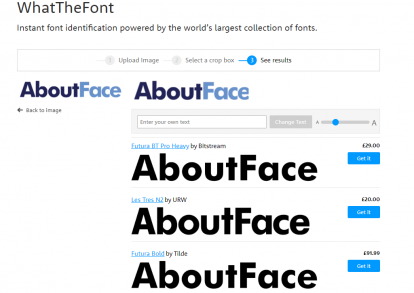

But a lot of the time, the one you're looking for will be up in the top 10. WhatFontIs will give you 100 results, which means that a lot of them won't look anything at all like the font you're looking for - after all, there likely aren't 100 fonts that are similar to the one you're seeking. Be sure to type the uppercase letters in uppercase and the lowers in lower, or else you'll get bad results.

Type in which letter corresponds with which image. As with most identifier sites, you upload your image, and it breaks the letters down one by one. My personal starting point is, primarily because they seem to have a better catalog of script fonts, and that's what people usually want help identifying. Save your image, and you're ready to hit the web! You can also color in any parts that turned out blotchy - I've touched up all of the letters except the "f" with black, and you can really tell the difference. I also like to put a new layer filled with plain white behind the letters, so I know that no stray other stuff will confuse the identifiers. Make sure none of the letters are touching, and crop your image to get rid of anything else. And how handy, they spell out a couple of words! It isn't necessary to rearrange the letters like this I just find it a little more fun when I can turn them into something silly. You only need one instance of each letter (so I don't have to do every "e"), and you should make sure to get the really distinctive letters in there (like that lowercase "s" - it's a very different shape than you usually see). Note: you don't need to grab every letter - I'm only going to select a few here. You may need to guess about where one letter ends and the next begins take a look at the last letter in the word for an idea about how far up the tail goes at the end of the letters in a connecting font. This is an especially important step with a connecting script font - you want the identifier tools to see each letter as a separate object. Use your lasso tool to select each letter, copy it, and paste it into a new layer. The online identifiers like black-on-white much better than white-on-black.) (If you're starting out with light text on a white background, I recommend using the "invert" tool first.

I've boosted green to the dark end, and the yellows and reds to the light end, so that I can get black text on a white background. I've taken advantage of the color sliders here - move a slider toward the white end, and any instances of that color in your picture will go lighter move a slider toward the black end, and that color will go darker. I've used the "black and white" tool in Photoshop (Image ^ Adjustments ^ Black & White) in order to convert the picture to grayscale. I've used a guideline in Photoshop to make sure I've rotated the picture so that the font is laid out straight. Since it looks fairly round here, I think this font is presented at its original dimensions. Fortunately, I don't think this font has been stretched at all - the lowercase "o" is usually a good guide. If the font looks obviously stretched or squished, you can also try to compact or expand it. (In my defense, it was really cold holding the freezer door open, so I took this quick.)įirst off, crop the part you want and rotate it (or use the skew, distort, or perspective tools in your image-editing program) so that it's as level and uniform as possible. If you're taking your own shot, try to get a picture of the product straight-on, so there are fewer adjustments to make later. I'll admit right now, I could have framed this picture much better. Here's a picture I took at the grocery store of a frozen pizza box - I liked the font that's being used for "deliciously dairy-free". I'm going to be taking a photo, adjusting it, and running it through a few of the font-identification websites so you can see the whole process.įind or take a picture of the mystery font: I have decent luck identifying these mystery fonts, so I wanted to share my techniques. Hello, all! Over at the fantastic WHAT FONT IS THIS? Facebook group, people frequently post a picture of an object and ask for help to find out the fonts used on that object.


 0 kommentar(er)
0 kommentar(er)
